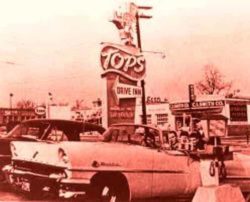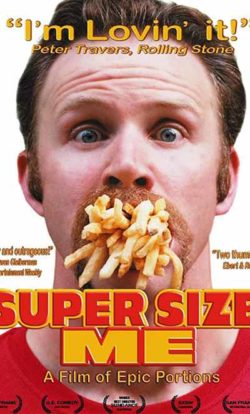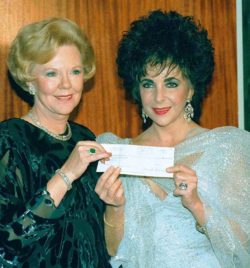Read Time: 5 Minutes Subscribe & Share
Days Of Yore
 My early teen years were spent hoping that my cool older brother would include me occasionally for a meal at Tops Drive-In. I dreamed of repeating the rare occasions when I would be ensconced in the back seat of his very nifty Ford convertible, with some of his equally cool but discreetly disreputable friends. White or pink shirts with matching socks, the sleeves rolled up to occasionally stash a pack of cigarettes, and of course the artfully combed hair. To pass through the drive-in, order a Sir Loiner and a shake was to me the epitome of aspirational teenagerdom. I think that I even wanted to be one of the spiffily dressed carhop girls who brought out your order, but my parents limited my jobs to babysitting. Tops also served as the first local platform for a Colonel Sanders and his fried chicken. You may have been denied this peculiar American rite of passage, as Tops and its menu, like so many other American chains and diners, were mowed under by the advancing Golden Arches, under the direction of Ray Kroc.
My early teen years were spent hoping that my cool older brother would include me occasionally for a meal at Tops Drive-In. I dreamed of repeating the rare occasions when I would be ensconced in the back seat of his very nifty Ford convertible, with some of his equally cool but discreetly disreputable friends. White or pink shirts with matching socks, the sleeves rolled up to occasionally stash a pack of cigarettes, and of course the artfully combed hair. To pass through the drive-in, order a Sir Loiner and a shake was to me the epitome of aspirational teenagerdom. I think that I even wanted to be one of the spiffily dressed carhop girls who brought out your order, but my parents limited my jobs to babysitting. Tops also served as the first local platform for a Colonel Sanders and his fried chicken. You may have been denied this peculiar American rite of passage, as Tops and its menu, like so many other American chains and diners, were mowed under by the advancing Golden Arches, under the direction of Ray Kroc.
The Real Founders
Since these iconic arches are woven into the fabric of everyone’s life in the US (and pretty much globally) and with McDonald’s feeding an astonishing 1% of the world’s population every day, I thought you might enjoy this docudrama that is somewhat under the radar. The Founder offers a stellar performance by Michael Keaton as Kroc, with Laura Dern serving as his worried and questioning first wife. But the scene stealers are the two actors who portray the McDonald brothers, who had developed a brilliant and, yes, quality-driven menu in their original drive-in franchise. (Contrary to what Kroc insisted in his autobiography, the brothers were actually the founders and had already added branches. But more importantly, they had developed the incredibly brilliant Speedee Service System, which revolutionized the fast food industry.)
The Director
John Hancock avoids trying to depict the wrongs that McDonald’s under the aegis of Ray and his corporate enablers have inflicted globally, but  rather focuses on the story of the players involved. The number of films, and journalistic output discussing the damage caused by McDonald’s and its clones is legion. Supersize Me, and this well researched article in The New York Times are just two examples worth watching and reading. When The Founder was completed, McDonald’s corporation very wisely decided not to litigate its meticulous production, as it would only attract greater attention and comment. Aside from the excellent acting and fairly accurate story line, one of the most intriguing moments to me was the fleeting appearance of Joan Smith, who after an on again and off again relationship became Ray Kroc’s third and final wife. (There are some very interesting facts presented as the credits roll through at the end.)
rather focuses on the story of the players involved. The number of films, and journalistic output discussing the damage caused by McDonald’s and its clones is legion. Supersize Me, and this well researched article in The New York Times are just two examples worth watching and reading. When The Founder was completed, McDonald’s corporation very wisely decided not to litigate its meticulous production, as it would only attract greater attention and comment. Aside from the excellent acting and fairly accurate story line, one of the most intriguing moments to me was the fleeting appearance of Joan Smith, who after an on again and off again relationship became Ray Kroc’s third and final wife. (There are some very interesting facts presented as the credits roll through at the end.)
The Donor
 While Ray Kroc was, as depicted in the film, quite smitten with Joan Smith, he was also a fierce alcoholic. Their fights on their yacht, in their home and on trips with friends were well documented, as was her proactive membership in Al-Anon. But the interesting thing about Joan was that with this immense wealth, she became a stealth donor to some startlingly progressive organizations. Once Ray died, she dispensed with the Foundation that he had initiated (and its cushily rewarded board members) and paid out enormous sums to organizations that she read about or had discussed with close friends —among them groups that promoted education to disadvantaged youth, public health facilities and initiatives, African famine relief, an astonishing variety of arts organizations and public works and even the pursuit of world peace and an end to nuclear proliferation. She directed that her estate donate $1.5 billion to the Salvation Army to build around 30 community centers in poor neighborhoods across the US. NPR received $200 million from her estate. As the daughter of a railroad worker, she knew how beneficial community centers with activities and sports for children were, and as an adult she appreciated independent journalism. She literally gave away during her life and at her death the vast amount that Ray had made off the McDonald brothers. She worked with a small staff, in an unmarked office whose address and phone number were closely held secrets, according to the biographer of Ray And Joan.
While Ray Kroc was, as depicted in the film, quite smitten with Joan Smith, he was also a fierce alcoholic. Their fights on their yacht, in their home and on trips with friends were well documented, as was her proactive membership in Al-Anon. But the interesting thing about Joan was that with this immense wealth, she became a stealth donor to some startlingly progressive organizations. Once Ray died, she dispensed with the Foundation that he had initiated (and its cushily rewarded board members) and paid out enormous sums to organizations that she read about or had discussed with close friends —among them groups that promoted education to disadvantaged youth, public health facilities and initiatives, African famine relief, an astonishing variety of arts organizations and public works and even the pursuit of world peace and an end to nuclear proliferation. She directed that her estate donate $1.5 billion to the Salvation Army to build around 30 community centers in poor neighborhoods across the US. NPR received $200 million from her estate. As the daughter of a railroad worker, she knew how beneficial community centers with activities and sports for children were, and as an adult she appreciated independent journalism. She literally gave away during her life and at her death the vast amount that Ray had made off the McDonald brothers. She worked with a small staff, in an unmarked office whose address and phone number were closely held secrets, according to the biographer of Ray And Joan.
Roy Finley remarked in the film Can You Dig This that there were no grocery stores in his immediate South Central Los Angeles neighborhood but an unbelievable number of fast food places. A self-fulfilling prophecy of health problems and lack of cooking skills follow. I remember treating my firstborn to her first McDonald’s cheeseburger in our car as a special occasion. By the time my second daughter was about four years old, we were initiating her into the same rite of passage at McDonald’s. But it tasted weird and unpleasant to me, and she did not want to eat it. We never returned.
In contrast, I’ve learned that for two friends undergoing chemotherapy, a McDonald’s cheeseburger was the food of choice — the only flavor that was utterly predictable and guaranteed to overwhelm an ever-present bitter, metallic taste that’s one of chemo’s side effects. Familiarity, saltiness, and total consistency can occasionally save the day.

Kitchen Detail shares under the radar recipes, explores the art of cooking, the stories behind food, and the tools that bring it all together, while uncovering the social, political, and environmental truths that shape our culinary world.




Comments are closed here.
Follow this link to create a Kitchen Detail account so that you can leave comments!